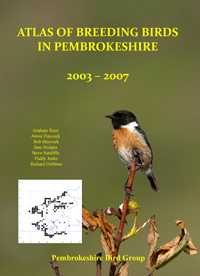Jay - 2003-07
 Monday, August 20, 2012 at 7:35PM
Monday, August 20, 2012 at 7:35PM The Jay is a medium-sized bird which is pinkish-brown in appearance, with blue and white wing patches, black tail and white rump. Despite its striking appearance, the Jay is shy and retiring and its presence is often first revealed by its raucous call. It is found in woodland and mature gardens, placing its nest close up to the trunks of trees or among thickets of ivy or thorns.
An estimate of 600 pairs breeding in Pembrokeshire was made at the close of the 1984-88 survey, based on an average density of three pairs per occupied tetrad. The 1988-91 National Atlas used an average density of four pairs per tetrad when calculating the UK total breeding population. The relative abundance map in that book indicates that this value might well have been applicable to Pembrokeshire. This would have elevated the county total to 800 pairs. The BBS charted a decrease of 14% across Wales between 1994 and 2007 and the survey of 2003-07 returned a 6% increase in distribution in the county. Applying the BBS value to the 2007 county distribution, results in an estimate of 730 pairs breeding in Pembrokeshire at the end of 2007.
Graham Rees

Fieldwork 2003-07 (based on 490 tetrads)
Red = breeding confirmed = 31
Orange = breeding probable = 85
Yellow = breeding possible = 96
Total tetrads in which registered = 212 (43.3%)
 GHR,
GHR,  PBBA 2003-7 in
PBBA 2003-7 in  Jay
Jay 











